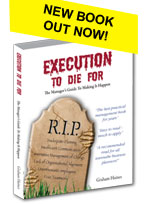1.2.8 Customer Service - How To Lose Customers Without Really Trying
Some pieces of research really stick in your memory and two that stick in mine were both conducted by the same organisation – Technical Assistance Research Programs Inc of Washington DC.
The first of these concerns reasons for customer defection. According to a study undertaken by TARP, 1% did so because the supplier died, 3% did so because the supplier moved, 5% did so because an alternative supplier was recommended, 9% did so because a competitor’s product was preferred, 14% did so because they did not like the supplier’s product but a massive 68% changed suppliers because the current one appeared disinterested or indifferent to their needs.
I was reminded of this research again recently when I finally made a decision to change banks. I had banked with one of the Big Four for 25 years and a couple of years ago in response to my complaint that I could never speak to the same person twice in succession I was informed that I now had a business banking manager to personally take care of my needs. The business banking manager was handily located in Brisbane so all through the summer months I had to cope with the impact of daylight saving.
Then when I rang one day, I discovered that my business banking manager had changed and the replacement was even incapable of changing the amount on a direct debit. Now I have a new bank, am on first name terms with the manager and if I need to speak to him face to face, he is about three minutes away. I’m sure that I am not his most important customer but I do feel that he is interested in my needs.
Many companies divide their customers up into hierarchical groups – A, B and C customers and when I see this, it makes me nervous. I have an instant empathy for those in the C category.
If you really cannot or don’t wish to meet the needs of your C category customers, at least be honest enough to tell them and perhaps even help them find an alternative supplier.
What’s the one thing that causes you more frustration when dealing with a supplier than any other? I know what mine is.
It’s not promptly responding to e-mails and phone calls, closely followed by people who don’t do what they say they are going to do.
I know that sometimes it’s not possible to respond or do what you say you are going to do but that’s not an excuse for doing nothing. Rather than have a voicemail message saying that you will return a call as soon as possible (having left for three weeks leave) you could record a new message saying when you will be back in the office and giving another number to be used in an emergency. You could have an out of office reply to an e-mail and if you can’t get back to someone with information in the time frame you promised, you could at least tell them that’s the case.
These are not major things but the message that your customer receives is loud and clear – we don’t really care about your business because in the final wash-up, we don’t really need it. It’s like that recorded message so beloved of large organisations that tells you how important your phone call is to them after you have waited for 15 minutes and heard every message-on-hold ten times over.
Remember – 68% of customers change their suppliers because they perceive that you are disinterested in their needs - and what better way to show it than any of the above.
Our own customer feedback surveys would support the TARP study. Let me pick out two comments from customers rung in the last few days.
“We had a problem with quality and rang the rep and he said that he would see us the next day but he didn’t turn up for three. We decided to change suppliers.”
“They seemed keen to get our business but once the agreement had been signed, they seemed to lose interest.”
Contrast the above with another. “For what it’s worth, I must tell you that the rep is fantastic. She always rings me before she comes and if I ask her a question, she always gets back to me when she says she will”.
Interestingly, both the first and the third comments refer to the same supplier.
If you are a professional services provider as many of my clients are, you must realise that in the great majority of cases, quality of service is far more important as a differentiator than quality of work.
This brings me to the second piece of TARP research. It’s been quoted many times before but that in no way invalidates the findings. The average person who has suffered at the hands of a supplier tells nine to ten colleagues. 13% will spread the word to twenty or more people.
Bearing in mind that the same study also concluded that it cost five times more to go out and get a new customer than it did to keep an existing one, can you really afford to upset your C category customers by appearing indifferent to their needs?
If you feel that this is an attitude prevalent in your organisation, you can do something about it. Ask your staff to calculate the potential value of a customer over the next five years. Then add to that favourable word-of-mouth commendation and lastly, set the example yourself.






